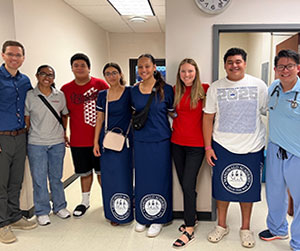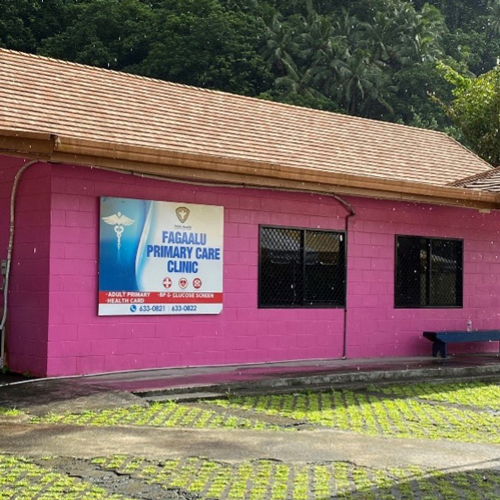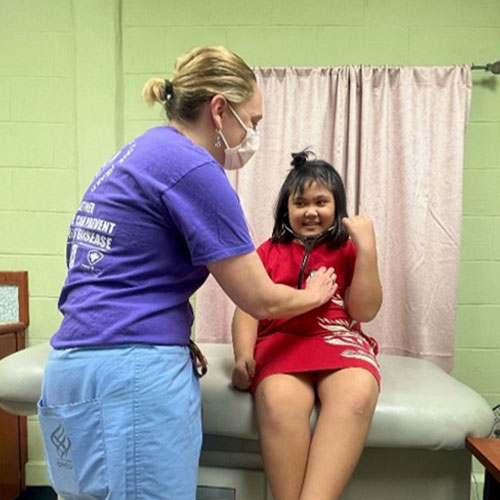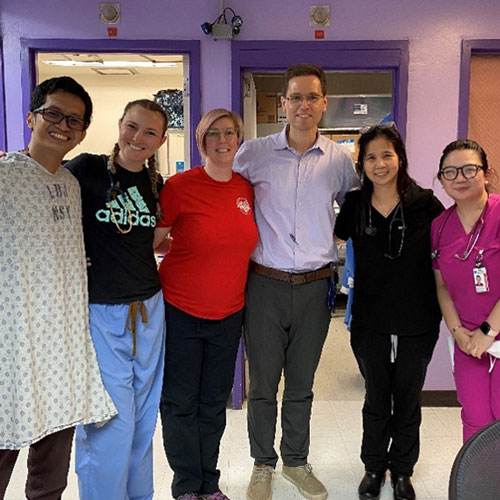
Courtney Dobson, RDCS, RCCS, a pediatric cardiac sonographer at Oregon Health and Science University (OHSU)/Doernbecher Children’s Hospital went on a medical mission trip to a tiny, remote Polynesian island in the south-central Pacific Ocean in February. She returned with renewed vigor for sonography. Courtney is the recipient of the 2023 SDMS Foundation International Assistance grant, which helped offset her mission trip expenses, including travel.
Roundabout Road to Sonography Mission Work
Growing up in California, Courtney earned a bachelor’s degree in exercise physiology and was on a path to becoming a teacher, like her mother. Illness waylaid those plans and opened a door to a career in sonography instead.
“When I was sick, I had to get a lot of tests and one I remember getting was an ultrasound, which seemed really interesting to me,” she recalls. When her health returned, she pursued a sonography program in California. “We had to do an internship, and the school was already working with Children’s Hospital of Los Angeles (CHLA) to set up a pediatric position.
“I had already chosen my path of doing cardiac ultrasound. I had completed that, and it was primarily working with adults. That’s what they gear you for,” she says. But Courtney had spent time in the classroom as a teacher to 30 to 50 kids at a time. “I thought, I could certainly work with kids one-on-one as a pediatric cardiac sonographer,” says Courtney. She stayed at the sonography program an additional three months, working as a teaching assistant, while the CHLA internship was in the final throes of preparation. Then, she was on her way, heading directly into pediatric cardiac sonography.
When Courtney started her sonography career, she had minimal exposure to medical mission work. Besides hearing about programs like Doctors without Borders, her first mission-type of experience came when she worked in Phoenix with a program that had a government contract with the Navajo Reservation. Teams visited the reservation twice a year. She was the last sonographer to go on that trip before it folded when the contact ended.
Later, when Courtney was hired at OHSU, she wasn’t aware they had a longstanding commitment to eradicating rheumatic heart disease in children in American Samoa through early detection/treatment and prevention. That’s because she was hired during the pandemic – the program was on hold. When it resumed last fall, Courtney’s interest was immediate but the first mission trip would occur too quickly, in just three weeks. The next invitation came five months later. She was enthusiastically on board.

OHSU Team Treks to Pago Pago, American Samoa
From February 2 to February 9, 2023, the OHSU team worked for 10 hours a day in a rheumatic heart disease clinic in Pago Pago in the Eastern District of American Samoa. American Samoa, an active U.S. Navy base from 1900 to 1951, is now home to 44,000 residents (11,500 in Pago Pago). Tourism and canning are major industries and the climate is tropical, with 200 inches of rain and high humidity that support a rainforest inhabited by bats, lizards, snakes, and insects. But most crucially, healthcare facilities are meager (1 hospital bed and .48 physician per 1,000 population) and equipped only to provide routine medical treatment. Medical evacuations to the mainland U.S. are prohibitively expensive. Teams like this save lives.
In addition to Courtney, other OHSU members of the team were:
- Kathy Holmes, MD
- Derek Weyrauch, MD
- Jenny Mustard, MD
- Laurie Armsby, MD
- Timothy Taber, sonographer
- Bruce Han, Fellow
Accessing the island’s healthcare services, including the clinic where the team worked, requires dedication and effort by residents. “Traveling from one side of the island to the other can take an hour. They wait their turn for a sonography exam, visit the doctor, and any follow-up care, such as injections. It’s a full day,” says Courtney. The team brings services that are not typically or widely available.
“We performed echocardiograms on known heart patients, identified new potential patients with rheumatic heart disease or congenital heart disease, and provided training to local staff to enhance their ultrasound skills in congenital cardiac ultrasound,” Courtney says. “A mission like this seeks to improve the overall health of this isolated community with only limited access to advanced care, such as pediatric cardiology and congenital cardiac ultrasound.”

OHSU’s commitment to help eradicate American Samoa’s rheumatic heart disease crisis was described in a 2012 blog post by Laurie Armsby, MD, one of the physicians on the trip in February. In addition to providing training and treatment, OHSU develops educational programs and preventive measures to reduce the incidence of untreated strep infections.
Without treatment, strep throat or impetigo, a strep skin infection, may result in heart murmurs and leave children breathless from even minor exertion. “Strep bacteria inflames the valves of the heart so they become scarred and thickened, stiff, leaky, and dysfunctional; this can lead to heart failure in kids from age 6 to 17,” Dr. Armsby wrote in her blog post.
Courtney has learned that when OHSU’s medical mission to American Samoa began more than 10 years ago, there weren’t enough strep tests for all the people who needed testing because the problem was so massive. The residents have come to understand the need and the value of preventing illness. “When you get rheumatic heart fever, you have to take intramuscular injections of benzathine penicillin G (BPG) every three to four weeks for a prolonged period of time, up to age 40, so, it’s a long ordeal,” she said.
Behavioral change has taken years of painstaking effort. But now, Courtney says, team members see signs of improvement, with residents getting tested and seeking care sooner. “It’s invigorating to know that we are making a difference and helping children live full, healthy lives,” she says. “The doctors say the patients are getting much better about taking their medicine. They’re actually getting people to come in a get tested when they have a sore throat. So they have seen improvements over the years.”
Passion to help children has driven Courtney all her life. It may have motivated her interest in teaching. It was certainly the reason she entered healthcare in the first place, she says. “Children are small and vulnerable. To this day, people still ask me, isn’t it depressing (to work among children who are so sick and could die without treatment)? No, it’s not because now we can do these amazing treatments and surgeries. These kids live. We’re getting them into adulthood. They’re having families. They’re growing up. It’s a very encouraging feeling to be involved in it. I don’t find it depressing at all,” says Courtney.
Heartbreak One Moment, Laughter the Next
The positive spirit Courtney finds in medical mission work still, at times, can be torn by poignant, heartrending moments. “One day, an adult patient (over age 18) showed up at the pediatric clinic. He apparently had been a patient four years earlier and had two of his heart valves repaired by OHSU. I don’t know what happened, but his rheumatic fever had returned. He was going to need another valve replacement. That was shocking and sad to see a young patient have to go through those kinds of surgeries again and so soon,” she says.
But the island oasis is filled with surprises and soon the emotional load is lightened. “From the window where I was scanning, I could see chickens walking back and forth,” says Courtney. “I found it hilarious. Every time I saw them, it brought a smile to my face. I’m at work at a medical clinic and there are chickens wandering about.”
In teaching the local staff new sonography skills and demonstrating the ultrasound views necessary to identify congenital heart disease, Courtney leaves nothing to chance. “Each day while we were hosting the clinics during the week, the local staff could practice their new skills. This is vital for the care of the local population, to enable the local staff to feel empowered to provide assistance to the community,” she explains.
The team saw 150 to 200 patients during the week, starting the clinic between 7:30 and 8 a.m. and ending at close to 6 p.m. Because advanced health care is more of a novelty in Pago Pago, Courtney found the work invigorating. On the island where rheumatic heart disease still affects the very young, there is a life-and-death purpose to the team’s healthcare services.
Her medical mission left her with food for thought and an interest in doing such work again. She knows that even on the mainland U.S., some areas, particularly rural communities, also have difficulty accessing healthcare.
“It made me feel good to serve a population dealing with a genuine healthcare crisis. I felt like I was really helping people, and that’s why I’m in healthcare,” says Courtney.
